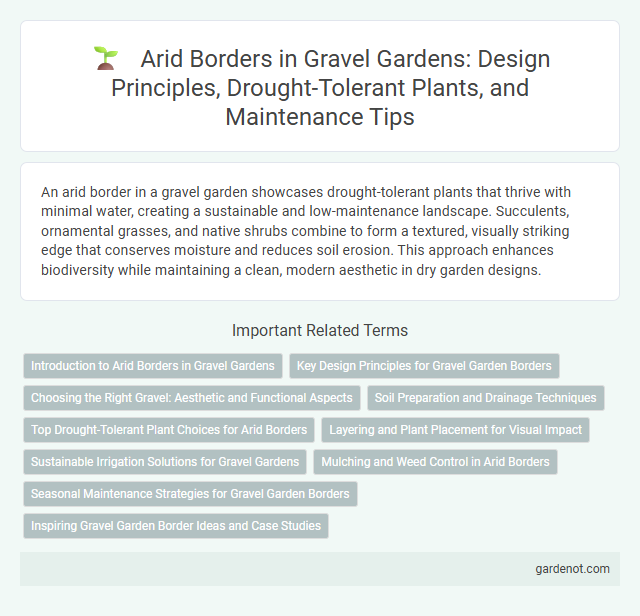An arid border in a gravel garden showcases drought-tolerant plants that thrive with minimal water, creating a sustainable and low-maintenance landscape. Succulents, ornamental grasses, and native shrubs combine to form a textured, visually striking edge that conserves moisture and reduces soil erosion. This approach enhances biodiversity while maintaining a clean, modern aesthetic in dry garden designs.
Introduction to Arid Borders in Gravel Gardens
Arid borders in gravel gardens create low-water landscapes by combining drought-tolerant plants such as lavender, rosemary, and succulents with well-draining gravel mulches to enhance moisture retention and soil aeration. These borders prioritize xeriscaping principles, reducing irrigation needs while supporting biodiversity in arid climates through native and Mediterranean species adapted to heat and minimal rainfall. Gravel surfaces minimize weed growth and soil erosion, providing a sustainable, visually appealing habitat that thrives in harsh, dry garden conditions.
Key Design Principles for Gravel Garden Borders
Gravel garden borders thrive on strategic soil preparation, emphasizing well-drained, sandy or loamy substrates to prevent waterlogging. Incorporating drought-tolerant plants with varied textures and heights enhances visual interest while maintaining low maintenance. Edging materials like metal or stone effectively contain gravel, ensuring clean lines and preventing displacement in arid garden settings.
Choosing the Right Gravel: Aesthetic and Functional Aspects
Selecting the right gravel for an arid border combines aesthetic appeal with practical benefits like drainage and heat retention. Opt for light-colored, angular gravel to reflect sunlight and reduce soil temperature, enhancing plant health in dry conditions. Textural contrast between gravel size and surrounding plants also improves visual interest and prevents weed growth effectively.
Soil Preparation and Drainage Techniques
Arid borders in gravel gardens require well-drained, sandy or loamy soil to prevent waterlogging and root rot. Incorporating coarse sand, grit, and organic matter improves soil structure and promotes rapid drainage. Raised beds and installing drainage pipes or gravel layers beneath the topsoil further enhance water flow and maintain optimal moisture levels.
Top Drought-Tolerant Plant Choices for Arid Borders
Arid borders thrive with drought-tolerant plants such as lavender, yarrow, and sedum, which require minimal water and withstand intense sun exposure. Incorporating drought-resistant grasses like Festuca glauca alongside cacti and succulents enhances texture and resilience in gravel garden designs. These plants optimize water conservation, reduce maintenance, and create a sustainable, visually striking arid border.
Layering and Plant Placement for Visual Impact
Layering and plant placement in an arid gravel garden border create depth and texture essential for visual impact. Drought-tolerant species like lavender, sedum, and ornamental grasses should be strategically arranged in height gradients, with taller plants at the back and low-growing ground covers in front. Using varied foliage colors and shapes enhances contrast, while spacing plants to allow mature growth prevents overcrowding and promotes healthy development.
Sustainable Irrigation Solutions for Gravel Gardens
Sustainable irrigation solutions for gravel gardens in arid borders emphasize water-efficient techniques such as drip irrigation and rainwater harvesting to reduce water consumption. Utilizing drought-tolerant plants and soil amendments enhances moisture retention, minimizing irrigation frequency. Integrating smart irrigation controllers optimizes watering schedules, ensuring plants receive precise hydration while conserving resources.
Mulching and Weed Control in Arid Borders
Mulching in arid borders helps retain soil moisture and regulates temperature, essential for drought-tolerant gravel garden plants. Using organic or inorganic mulch reduces weed growth by blocking sunlight and creating a physical barrier. Effective weed control minimizes competition for water and nutrients, enhancing plant health and landscape aesthetics in gravel gardens.
Seasonal Maintenance Strategies for Gravel Garden Borders
Seasonal maintenance strategies for arid gravel garden borders include regular weeding and the application of organic mulch to retain soil moisture and suppress invasive plants. Monitoring soil drainage and adding fresh gravel annually helps prevent compaction and maintains aesthetic appeal. Pruning drought-tolerant plants such as lavender and sedum in early spring encourages healthy growth and enhances border structure.
Inspiring Gravel Garden Border Ideas and Case Studies
Arid borders in gravel gardens showcase drought-tolerant plants such as lavender, sedum, and ornamental grasses that thrive in well-drained, low-moisture soils. Innovative case studies highlight the use of layered textures and contrasting colors to create visual interest while minimizing water usage. These designs emphasize sustainability and resilience, making them ideal for eco-friendly landscaping with minimal maintenance.
Arid border Infographic

 gardenot.com
gardenot.com